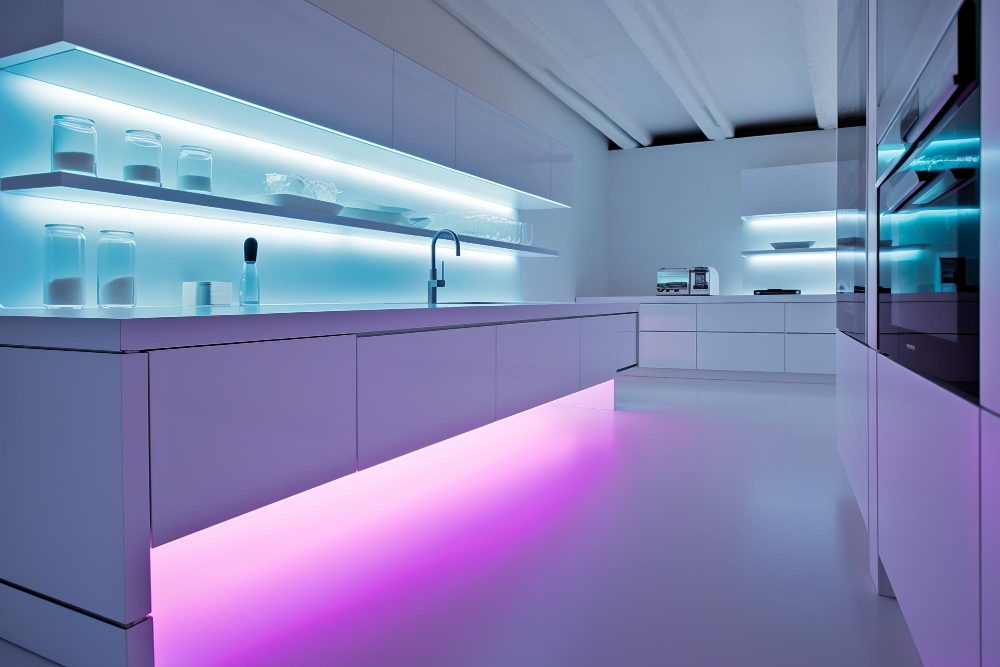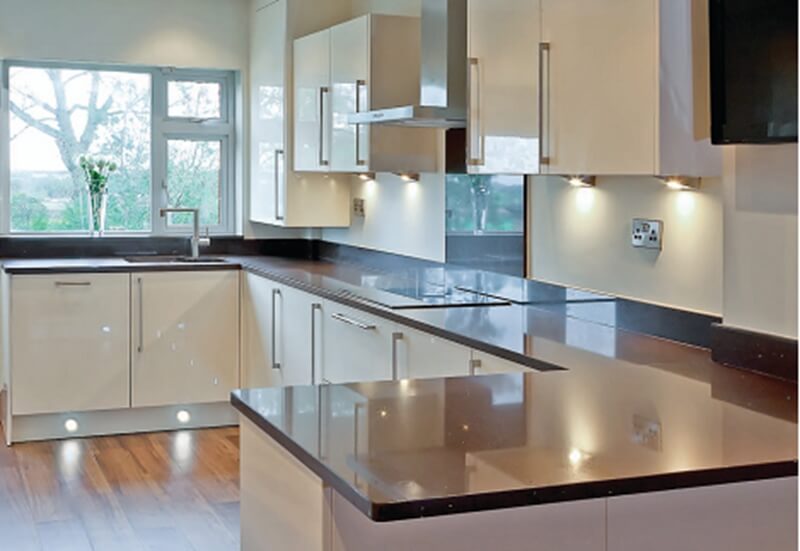Understanding Puck and Strip Under Cabinet Lighting

Illuminating your kitchen or workspace with under-cabinet lighting can significantly enhance functionality and aesthetics. Two popular choices for this application are puck lighting and strip lighting. Both offer unique advantages and drawbacks, making it crucial to understand their characteristics before making a decision.
Puck Lighting
Puck lighting consists of small, round fixtures that emit light in a focused beam. These fixtures are typically LED-based, offering energy efficiency and longevity.
Puck lights are available in various sizes and styles, including:
- Recessed Puck Lights: These lights are installed flush with the cabinet surface, creating a sleek and minimalist look. They are ideal for creating ambient lighting and highlighting specific areas.
- Surface-Mount Puck Lights: These lights are attached to the underside of the cabinet with adhesive or screws. They offer flexibility in placement and are suitable for accent lighting or task lighting.
- Magnetic Puck Lights: These lights have a magnetic base that allows them to be easily attached to any metal surface. They are convenient for temporary or movable lighting applications.
Puck lights are commonly used for:
- Task Lighting: Providing focused illumination for tasks like cooking, preparing food, or working on projects.
- Accent Lighting: Highlighting specific features or areas within the kitchen, such as countertops or backsplashes.
- Ambient Lighting: Creating a soft and inviting atmosphere in the kitchen or workspace.
Strip Lighting
Strip lighting utilizes long, flexible LED strips that can be easily customized to fit various lengths and shapes. These strips are often equipped with an adhesive backing, allowing for effortless installation.
Strip lights offer numerous benefits, including:
- Versatility: They can be easily cut and shaped to fit any under-cabinet configuration, offering maximum flexibility.
- Brightness: Strip lights provide ample illumination, making them suitable for both task and ambient lighting.
- Color Options: Available in a wide range of colors, allowing for customization to match your kitchen’s décor or create a specific ambiance.
However, strip lights also have some drawbacks:
- Potential for Overheating: Some strip lights can overheat, particularly when used in enclosed spaces. It is essential to choose high-quality strips with adequate heat dissipation.
- Limited Beam Control: Strip lights typically emit a wide, diffused beam of light, which may not be ideal for focused task lighting.
- Installation Challenges: While easy to install, strip lights can be challenging to conceal, particularly when using multiple strips or long lengths.
Aesthetic Appeal
Puck lighting offers a more traditional and understated look, often blending seamlessly with the cabinet design. They are well-suited for creating a clean and modern aesthetic. Strip lighting, on the other hand, provides a more contemporary and dynamic look, with its linear design and customizable color options. The choice between puck and strip lighting ultimately depends on your personal preferences and the overall design aesthetic of your kitchen or workspace.
Installation and Functionality: Puck Vs Strip Under Cabinet Lighting

Installing under-cabinet lighting is a relatively straightforward process that can be accomplished with basic tools and some DIY skills. Both puck and strip lighting offer unique advantages and installation methods, making them suitable for different needs and preferences.
Installation Process
The installation process for both puck and strip lighting generally involves similar steps:
- Planning and Measuring: Determine the desired placement of the lights and measure the area where they will be installed. This includes considering the distance between fixtures, the length of the strip, and the overall layout of the lighting.
- Mounting the Fixtures: Secure the puck lights or strip lighting to the underside of the cabinets using adhesive tape, clips, or screws. Ensure the fixtures are securely mounted and aligned properly.
- Wiring and Power Connection: Connect the lights to a power source using the appropriate wiring and connectors. This may involve hardwiring the lights to a junction box or using a plug-in adapter. The type of power connection will depend on the chosen lighting system and the existing electrical infrastructure.
- Testing and Adjustment: Once the lights are installed, test them to ensure they are functioning correctly. Adjust the brightness or color temperature as needed. This may involve using a dimmer switch or adjusting the settings on the lighting system.
Power Connection Methods, Puck vs strip under cabinet lighting
Puck and strip lighting offer several power connection options, each with its own advantages and considerations:
- Hardwired Connection: This method involves connecting the lights directly to the electrical wiring in the house. It provides a permanent and reliable power source, but requires professional electrical work and may not be feasible in all situations.
- Plug-in Adapter: This option uses a standard plug to connect the lights to a wall outlet. It is a convenient and flexible solution, but may require an extension cord for reach and can limit the number of lights that can be connected.
- Battery-Powered: Some puck and strip lights are powered by batteries, offering a portable and wireless solution. However, battery life can be limited and requires regular replacement. This option is suitable for temporary installations or areas without easy access to electrical wiring.
- USB Power: Some strip lights can be powered by a USB port, offering a convenient and versatile solution. This option is particularly suitable for areas where USB ports are readily available, such as under a desk or countertop.
Ease of Installation and Maintenance
- Puck Lighting: Puck lights are generally easier to install than strip lighting, as they are individual fixtures that can be mounted independently. However, they may require more wiring and connections if multiple pucks are used. Maintenance is typically straightforward, involving replacing individual bulbs as needed.
- Strip Lighting: Strip lighting offers a continuous line of light, providing a more seamless and modern look. Installation can be more challenging, especially for longer strips or complex layouts. Maintenance may involve replacing the entire strip if a section fails, but some strips have replaceable segments.
Practical Considerations

When deciding between puck and strip under-cabinet lighting, it’s essential to consider the practical aspects that align with your kitchen’s specific needs and preferences. Understanding the advantages and disadvantages of each type can guide you towards the best choice for your space.
Puck Lighting: Pros and Cons
Puck lighting offers a focused, concentrated beam of light, making it ideal for illuminating specific areas. However, it might not provide sufficient overall brightness for the entire countertop.
- Pros:
- Focused Illumination: Puck lights provide a concentrated beam, ideal for highlighting specific areas, such as a cutting board or a sink.
- Energy Efficiency: LED puck lights are highly energy-efficient, reducing your electricity bill.
- Easy Installation: Puck lights are typically easy to install, often requiring only a few screws or adhesive strips.
- Variety of Styles: Puck lights come in various styles, including round, square, and rectangular, allowing you to choose a design that complements your kitchen’s aesthetic.
- Cons:
- Limited Coverage: Puck lights provide a focused beam, which might not adequately illuminate the entire countertop, especially in larger kitchens.
- Potential for Shadows: The concentrated beam of light can create shadows in areas not directly illuminated by the puck lights.
- Less Versatility: Puck lights are less versatile than strip lights, as they cannot be easily adjusted or repositioned.
Strip Lighting: Advantages and Disadvantages
Strip lighting offers a broader, more diffused illumination, making it suitable for illuminating larger areas. However, it might not provide the same level of focused light as puck lights.
- Pros:
- Wide Coverage: Strip lights provide a broader, more diffused illumination, effectively illuminating the entire countertop and surrounding areas.
- Adjustable Brightness: Many strip lights offer adjustable brightness settings, allowing you to customize the lighting level based on your needs.
- Versatile Installation: Strip lights can be installed in various configurations, including under cabinets, along countertops, or even behind backsplashes, offering flexibility in placement.
- Color Temperature Options: Strip lights are available in various color temperatures, allowing you to create a warm, cool, or neutral ambiance.
- Cons:
- Less Focused Illumination: Strip lights provide a broader, more diffused light, which might not be ideal for tasks requiring focused illumination, such as chopping vegetables.
- Potential for Glare: Depending on the placement and type of strip lights, they might cause glare, especially when reflected off shiny surfaces.
- More Complex Installation: Strip lights might require more complex installation, especially if you want to customize the configuration or integrate them with a smart home system.
Choosing the Right Lighting Option
The best lighting option for your kitchen depends on your specific needs and preferences.
- For focused illumination: Puck lights are ideal for tasks requiring concentrated light, such as chopping vegetables or preparing food.
- For broader illumination: Strip lights are suitable for illuminating the entire countertop and surrounding areas, providing a more general lighting effect.
- For energy efficiency: Both puck and strip lights are available in LED versions, which are highly energy-efficient.
- For aesthetics: Choose a lighting option that complements your kitchen’s style and design.
Puck vs strip under cabinet lighting – Choosing between puck and strip under cabinet lighting can be a tough decision. Both offer unique benefits, but the best option ultimately depends on your specific needs and preferences. To help you make an informed choice, check out our under cabinet lighting reviews from 2019 for a comprehensive overview of popular models.
You’ll find insights on features, performance, and value, allowing you to make a well-informed decision on whether puck or strip lighting is right for your kitchen.
Puck lights and strip lights are both popular choices for under-cabinet lighting, but they offer different aesthetics and functionalities. If you’re currently using fluorescent lights, you can upgrade to LED strips for a more energy-efficient and longer-lasting solution. Changing under cabinet fluorescent light to led can significantly improve your kitchen’s lighting, and when considering puck vs strip, it’s crucial to weigh the pros and cons of each option for your specific needs.
